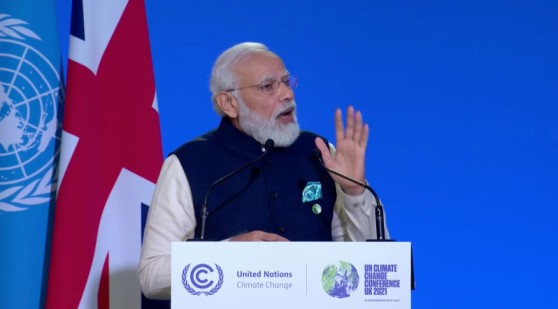COP26: PM Modi announces India’s commitment to achieve net-zero emission by 2070. Here’s what experts have to say
At the 26th international climate conference in Glasgow, PM Narendra Modi announced that India would reduce its carbon emissions intensity by close to 45 per cent and reduce one billion tonne carbon emissions by 2030. A section of experts have hailed this ambitious commitment as a welcoming step. More details here.


Prime Minister Narendra Modi outlined five commitments for India at COP26. Photo : Screengrab from PM's Glasgow address
Yesterday on November 1, Prime Minister Narendra Modi presented India’s agenda to tackle climate change at the 2021 United Nations Climate Change Conference, also known as COP26, being held in Glasgow, Scotland, United Kingdom between October 31 and November 12.
Modi announced India’s pledge to commit net zero emissions by 2070 and the target of installing 500 gigawatt (GW) of non-fossil fuel capacity by 2030. Net zero, or becoming carbon neutral, means not adding to the amount of greenhouse gases in the atmosphere.
This is the first time that India has pledged to achieve net zero emission by 2070 and announced to reduce carbon emissions by one billion tonnes by 2030. This commitment was not a part of the country’s 2015 Nationally Determined Contribution (NDCs) submitted in 2015.
India’s five-point agenda
The Indian Prime Minister presented his five-point agenda – amrit tattva (nectar elements) – while delivering the ‘National Statement’ at the COP-26 summit. These include raising non-fossil fuel based energy capacity (renewable energy) of the country to 500 GW by 2030; meeting country’s 50 percent energy requirements using renewable energy sources; reducing the total projected carbon emission by one billion tonnes by 2030; reducing carbon intensity of the economy to less than 45 percent by 2030; and achieving net zero emissions by 2070.
Whereas a large section of environmental experts in India have hailed this commitment of net zero by 2070 as real climate action, some have termed it weak.
“India has clearly put the ball in the court of the developed world. Now India demands US$ 1 trillion in climate finance as soon as possible, and will monitor not just climate action but also climate finance. Most importantly, India has called once again for a change in lifestyle. If we cannot fix how we live, we can’t fix how we live on this planet,” Arunabha Ghosh, CEO of Council for Energy, Environment and Water, a leading policy research institute and think tank based in Delhi, was quoted as saying.
Experts’ voices
According to a brief paper by Global Strategic Communications Council (GSCC), a global network of communications professionals in the field of climate and energy, the commitment of 500 GW non-fossil fuel capacity will effectively increase India’s installed non-fossil capacity from 40 per cent to more than or equivalent to 60 per cent by 2030.
A target of 500 GW non-fossil fuel capacity will also mean India won’t have to build any new coal power plant.
The brief paper also stated that 500 GW of non-fossil fuel capacity in the electricity system will make India’s thermal assets – which are suffering from low efficiency, vagaries of import prices, and demise of global investment in coal – languish even further.
Currently, India is heavily dependent on coal and 50 per cent of the carbon dioxide emissions in the country is generated from coal, Chandra Bhushan, a leading environment and climate expert, who is the founder of iFOREST, had told Gaon Connection in a recent episode of Gaon Cafe on coal shortage in India.
Experts see this as a step as an unprecedented, quick transformation of the energy sector. “The commitment of 500 GW of renewable energy by 2030, which is more than twice the installed capacity of coal currently, should set the stage for a quick transformation of the energy sector,” Aarti Khosla, director at Climate Trends, was quoted as saying. “Ensuring that the new energy regime doesn’t bring the pitfalls of the current regime will be fundamental. Solar and wind are poised to emerge as the future in the net zero world,” she added.
Madhura Joshi, a senior associate at India Lead, E3G said that the COP26 commitment has set India firmly on a clean energy pathway and net-zero can be achieved by India earlier than 2070. “While one reading of these targets could mean that the government is leaving some wriggle room on coal, we know, and several studies have shown, that new coal capacity is both completely uneconomical, and not needed for India’s energy future. Judging by past performance, India often does better than its set targets,” she added.
While some experts see it as a welcoming step however a few believe that net zero by 2070 might mean something diplomatically however it will not be what drives change in India.
“Much more intriguing are the announcements on railways, on non fossil capacity and the benchmark for renewable energy. These are what give scope for India to drive a low carbon development transition in the next decade,” Navroz Dubash, professor with the Centre for Policy Research pointed.
Other countries like China have announced plans for carbon neutrality by 2060, while US and European Union plan to achieve net zero by as soon as 2050.

